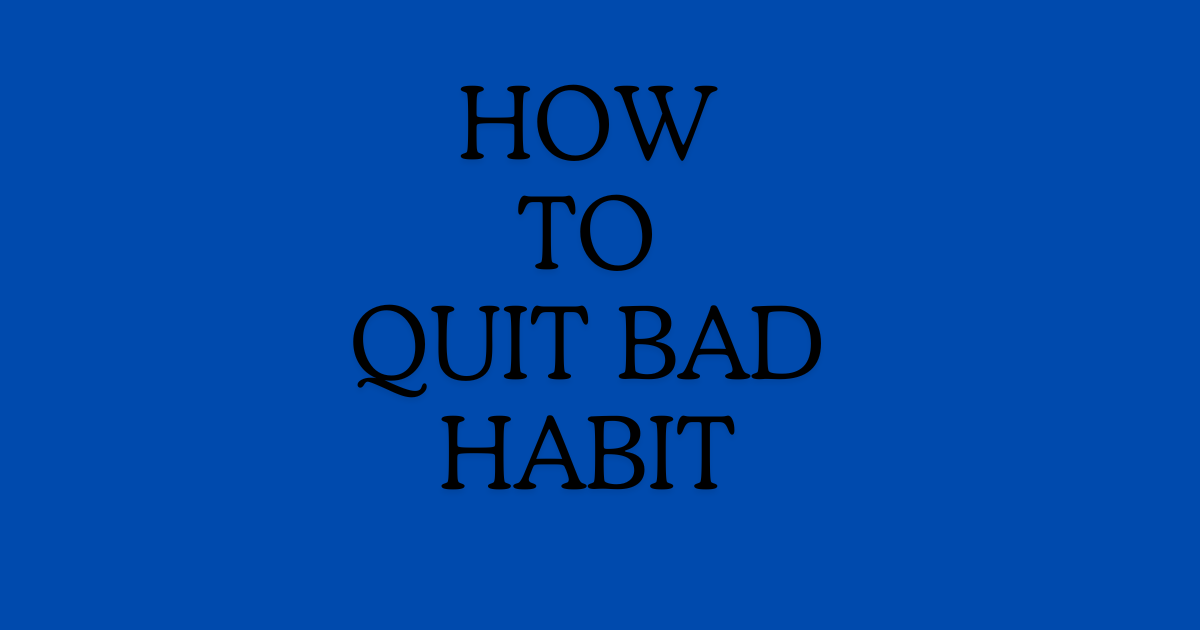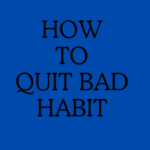Preface
Embarking on the journey to quit a bad habit is a transformative and empowering decision. Whether it’s smoking, overeating, procrastination, or any other unwanted gesture, the process can be grueling but immensely satisfying. In this guide, we will explore effective strategies and ways to help you break free from the clutches of your bad habit and foster lasting positive change.Artical will help us to answer,how to quit bad habit.
Table of Contents
Understanding the Psychology of Habits
Before diving into the strategies for quitting a bad habit, it’s essential to understand the psychology behind habit formation. Habits are frequently deeply hardwired behavioral patterns that develop through repetition. They create neural pathways in the brain, making the gesture automatic and occasionally challenging to change. Feting the cerebral aspects of habits lays the root for successful habit metamorphosis.
Acknowledge and Identify the Habit
The first step towards breaking a bad habit is admitting its actuality. It’s pivotal to be honest with yourself and identify the specific habit you want to quit. Whether it’s nail-biting, inordinate screen time, or negative tone-talk, clarity about the habit provides a starting point for effective intervention.
Set Clear and Achievable Goals
Once you’ve linked the habit, set clear and attainable goals. Break down the process of quitting into lower, manageable ways. This not only makes the trip less inviting but also allows you to celebrate small palms along the way, buttressing positive gesture.

Understand Alarms and Replace with Alternatives
Habits are frequently touched off by specific cues or situations. Identify the triggers associated with your bad habit and work on replacing them with healthier druthers. For illustration, if stress triggers your smoking habit, consider espousing stress-relief ways like deep breathing, contemplation, or exercise.
Build a Support System
Quitting a bad habit is more attainable when you have a support system in place. Partake your pretensions with musketeers, family, or a tutor who can give stimulant, understanding, and responsibility. Having someone to lean on during grueling moments can make a significant difference.
Use Positive Reinforcement
Positive reinforcement involves satisfying yourself for making progress. Establish a system of prices for reaching mileposts in your trip to quit the bad habit. These prices can be as simple as treating yourself to something you enjoy or taking time for a favorite exertion. Positive reinforcement strengthens the neural pathways associated with positive gesture.
Seek Professional Help if Demanded
Some habits may bear professional backing to overcome successfully. However, consider seeking help from a therapist, counselor, if you find that your habit is deeply hardwired and affecting your well-being. Professional guidance can give precious perceptivity and acclimatized strategies for prostrating specific challenges.
Adopt a Healthy Lifestyle
Improving overall well-being can significantly contribute to breaking bad habits. Focus on espousing a healthy life that includes regular exercise, balanced nutrition, and sufficient sleep. Physical well-being is nearly linked to internal and emotional health, creating a foundation for positive habit change.
Practice Awareness and Tone-Mindfulness
Awareness involves being completely present in the moment and observing studies and passions without judgment. Incorporate awareness practices into your diurnal routine to increase tone-mindfulness and break the automatic nature of the habit circle. Ways similar as contemplation and aware breathing can be important tools in your trip to quit a bad habit.
Learn from Setbacks
Quitting a bad habit is a process, and lapses are a natural part of the trip. Rather than viewing lapses as failures, see them as openings to learn and acclimate your approach. Dissect the factors that led to the reversal, and use this information to upgrade your strategy for prostrating the habit.
Create a Healthy Terrain
Your terrain plays a significant part in shaping gesture. Modify your surroundings to support your thing of quitting the bad habit. Remove triggers, compass yourself with positive influences, and produce an environment that fosters the development of new, healthier habits.
Develop a Replacement Habit
Breaking a habit isn’t just about stopping the uninvited gesture; it’s also about replacing it with a positive volition. Identify a relief habit that aligns with your pretensions and values. For instance, if you are quitting smoking, consider taking up a new hobby or engaging in physical conditioning to enthrall your time and mind.
Celebrate Mileposts
Celebrate your achievements along the way. Whether it’s a week without the habit, a month of progress, or reaching a significant thing, take time to admit and celebrate your success. Fests serve as motivational boosts and support the positive changes you’ve made.
Stay Patient and Consistent
Quitting a bad habit is a trip that requires continuity and tolerance. Understand that change takes time, and lapses are part of the process. Stay married to your pretensions, stay patient with yourself, and continue moving forward, one step at a time.
Conclusion
Breaking free from a bad habit is a valorous and empowering bid. By understanding the psychology of habits, setting clear pretensions, erecting a support system, and espousing positive strategies, you can pave the way for lasting change. Flash back that each small step you take brings you near to a healthier, more fulfilling life.
FAQs
- How long does it take to quit a bad habit successfully? The time it takes to quit a bad habit varies for each existent. It depends on factors similar as the complexity of the habit, particular adaptability, and the effectiveness of strategies employed.
- Is it possible to quit a habit cold turkey? While some people successfully quit cold turkey, it may not be the most effective approach for everyone. Gradational, well-planned strategies frequently yield more sustainable results.
- Can professional help guarantee success in quitting a bad habit? Professional help can give precious guidance and support, but success eventually depends on the existent’s commitment and amenability to make changes.
- What part does tone-discipline play in quitting bad habits? Tone-discipline is pivotal in prostrating bad habits. still, developing a probative terrain, exercising positive underpinning, and seeking external support can enhance tone-discipline.
- Are there specific habits that are harder to quit than others? The difficulty of quitting a habit varies from person to person. Some habits may be deeply hardwired and grueling to break, while others may be more manageable with the right strategies and support.










